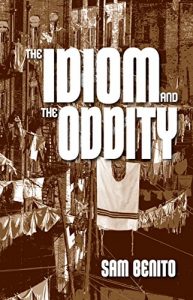
In the highly-polarized environment of contemporary Jewish culture, it’s easier to imagine a rosh yeshiva banning fiction than writing it. Imagine my surprise when I received a copy of The Idiom and the Oddity, a lightly veiled Bildungsroman that describes how this internationally recognized Haredi religious authority came to Orthodox observance.
He’s hidden his public identity behind a pseudonym (the author bio reads, “writer, educator and lecturer,” an understatement). Given our current intellectual climate, I can understand why: there’s certainly no salacious or otherwise inappropriate content in the 300-page novel, but even a superficial reading alludes to youthful experimentation with activities that, in the yeshiva, range from the merely frowned upon to the outright forbidden.
Bottom line? It’s a demanding read. But it’s literature.
The novel is set in late 1950s New York, when the protagonist–and one assumes, the author–experienced a spiritual awakening, embarking on a path that ultimately took our hero to the heights of leading a major yeshiva in Jerusalem. The book is divided into two rather large chapters that sit on either side of a major divide: the first describes the main character’s decision to leave his parents’ new, spacious home in suburban Long Island and return to his geographic roots in Brooklyn in order to be closer to a shomer Shabbat family, much to the ire of his father:
For Dad, my returning to the Brownsville war zone was an affront. Why? For what? Traffic was going the other way. So was the race. His Jewish-American marathon. I was running in the wrong direction! It was veritably anti-Jewish, not just non-Jewish, to go that route.
As a young boy, the author relates, his father wanted him to wear a watch in order to develop punctuality. Later, when the hero finally adopts the timepiece, his father is displeased because he wears it in order to be on time for Mincha.
The Rosh Yeshiva describes his quasi-heretical youth, from attenuated adherence to kashrut to a non-Jewish girlfriend who lives in, of all places, the Long Island community of Babylon. The Holocaust and its impact on his post-war youth permeates the pages, highlighting his liminal status as an American “crypto-Jew:” aware of more traditional practice, yet fundamentally alienated by it. His pseudonym, Sam Benito, alludes to that extended metaphor: the sanbenito is the humiliating tunic of the Inquisition, forced upon Jews who were unable to completely adopt new Christian identities in post-expulsion Spain.
It had come to pass, that one day looking into the mirror, of a moment, suddenly, there was a Jew looking back at me! Perhaps, a free-floating unemployed dybbuk had latched on for the ride. Or some musty, dusty, chained Marrano soul from the dungeon of my unconscious, at first furtively, then openly appearing, escaping suffocation.
Striding purposefully through the book, and the Rosh Yeshiva’s youth, is the aptly named Rabbi Shimshon. He rules over a dying congregation in Brooklyn known by its detractors as “Stalin’s Shul” because of a debate over whether or not a misheberach should be recited for the Red Army in their struggle with the Wehrmacht. Rabbi Shimshon is a kanoi, a newly immigrated zealot who left the safety of the United States shortly after the war broke out in order to rescue his family who were trapped behind enemy lines. Unbeknownst to Rabbi Shimshon, his wife and two of his children managed to evade the Nazi advance and made their way to America, while Shimshon was seized and subjected to the horrors of the Holocaust.
Scarred by the trauma, Shimshon ultimately survives the war and returns to America with a chilling determination to refuse any concessions to modernity: the Nazis destroyed his family, both those who were killed in Europe and those who experienced the soul-crushing despair known as yi’ush and abandoned Judaism. Shimshon, like his Biblical namesake, is prepared to tear down the very palace to uphold his religious principles (I will not spoil the plot here).
The protagonist of The Idiom and the Oddity is the Rosh Yeshiva’s alter ego, but the hero of the book is clearly Reb Shimshon. Although he initially comes across as a quaint, somewhat laughable relic of a vestigial past, over the course of the novel he rises to his full, majestic height. His concluding monologue–six pages of heavily accented of Yiddish rage, uninterrupted by even a single paragraph break–is one of the most chilling, sustained and memorable passages in the entire book.
The second half of the book takes place a few years later, when the protagonist begins to explore full-time Talmud study at a Yeshiva in Ellenville. A newcomer to full-time Talmudic studies, he describes his experience with a pathos that I remember with my own adult introduction to the yeshiva. Here Benito reflects on the gulf that separated him from the more experienced students:
Natives these bachurim, they knew the terrain. Sherpa-yeshivaleit, all steeped and nurtured in the law and mores of moving, climbing, negotiating, surviving, on these breathtaking craggy Talmudic ascents and inclines. They thrived in this heady altitude, on these trickly twisting icy slopes, fed and sustained on the rugged mountain fare. Thorny questions, and lofty concepts framed in jagged Aramaic phrases, fit comfortably into their mouths. They chewed and digested those words. They. Not me. I was an outsider…These heights brought the blood to my head. Not a Torah head, with a body as a disciple, instructed and informed by that head, but rather a Greek kind of head with body as instructor-conductor.
The metaphor of the oral Torah recurs at several points in the novel: “the condensed rhythmic style of the Gemara had a fascination…a kind of tight, pulsating logical poetry. But the words were like cubes of ice, those Aramaic words, and they would not melt on my tongue.” Not surprisingly, Yeshiva truisms are sprinkled throughout: “Time was told in the yeshivah by tractates. Shimmy came in Kedushin, Tuly in Bava Metsia, both left in Bava Kamma.”
Readers with an appreciation of Yeshiva culture (and baseball culture) will appreciate this work, but the author clearly assumes that his readers possess a basic working knowledge of the great canon of western literature and philosophy. I personally recall experiencing the broad erudition of the Rosh Yeshiva, evidenced by his silver-tongued derashot and shmuzzen, but even in my twenties I knew that most of my college-educated peers missed his references to philosophical and literary classics works that one would not typically find on the shelves of a haredi Bet Midrash.
The sheer breadth of the Rosh Yeshiva’s reading is sometimes a liability. I often found myself groaning at the excessive pun-per-page ratio, many of which involved several languages, and I’m not sure how a reader without a working knowledge of Kierkegaard, Shakespeare and Plato would manage the text. Consider this Coleridge-inspired passage: when his friend Marty is temporarily expelled from Talmud Torah classes for mocking Jewish practice, he calls it his “unwilling suspension of disbelief.” Or this Steinbeck Yiddishism: when a character named Roth defuses a tense moment with an ear-splitting belch, the incident is referred to as “the greps of Roth” (greps being Yiddish for burp).
The book is an hommage to Joyce above all: the trajectory of the plot borrows happily from Portrait of the Artist as a Young Man, the style from Ulysses (the lead character is even named Bloom), and even Joyce’s most enigmatic work gets a nod when an Irish character departs the story, leaving “Finnegan’s wake” in the aftermath.
Why would a Rosh Yeshiva feel the need to publish a novel of this nature? It is certainly not part of the “ex-Orthodox” genre that has gained so much traction in recent years, but it’s hardly an apology for Haredi Judaism, either. From what I know of the author–I had the privilege of studying with him be-chevruta many years ago, an experience that I especially cherish–his is a mind that, iceberg-like, only allows a tiny portion of his intellect to penetrate the surface of the water. I suspect that this is his literary legacy, at least in English, and his thought is such that it cannot be properly expressed outside the art of fiction. Unfortunately, in contemporary Yeshiva culture, fiction is verboten as bitul zman, “wasted time,” and the medium that might best express the Rosh Yeshiva’s vision is off limits under his own name. And yet, it had to be preserved, for as the Rosh Yeshiva writes, there are two important facts about life: 1) it is. 2) then it won’t be.
The words of this author reflect his/her own opinions and do not necessarily represent the official position of the Orthodox Union.
